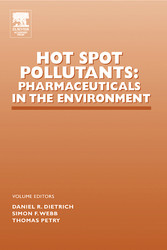Suchen und Finden
Cover
1
Title Page
4
Copyright Page
5
Contents
6
Contributors
16
Preface
20
Part I: Editorial
22
Chapter 1. Hot Spot Pollutants: Pharmaceuticals in the Environment
24
Text
24
References
27
Part II: Occurrence and Fate
30
Chapter 2. Occurrence, Fate, and Removal of Pharmaceutical Residues in the Aquatic Environment: An Extended Review of Recent Research Data
32
I. Introduction and Background
32
II. Occurrence of PhACs in Sewage, Surface, Ground, and Drinking Water
33
III. Conclusions
50
References
50
Chapter 3. The Sorption and Transport of a Sulphonamide Antibiotic in Soil Systems
58
I. Introduction
58
II. Methods
60
III. Results
63
IV. Discussion
66
V. Conclusions
68
References
69
Chapter 4. Concentrations of the UV Filter Ethylhexyl Methoxycinnamate in the Aquatic Compartment: A Comparison of Modeled Concentrations for Swiss Surface Waters with Empirical Monitoring Data
72
I. Introduction
72
II. Methods
73
III. Results
78
IV. Discussion
80
References
82
Chapter 5. Exposure Simulation for Pharmaceuticals in European Surface Waters with GREAT-ER
84
I. Introduction
84
II. GREAT-ER System Description
85
III. Output of GREAT-ER
87
IV. Methods
89
V. Results and Discussion
92
VI. Conclusions
96
References
97
Chapter 6. Indirect Human Exposure to Pharmaceuticals via Drinking Water
100
I. Introduction
100
II. Methodology
102
III. Results
102
IV. Discussion
106
V. Conclusions
112
References
113
Part III: Effects
116
Chapter 7. Morphological Sex Reversal Upon Short-Term Exposure to Endocrine Modulators in Juvenile Fathead Minnow (Pimephales promelas)
118
I. Introduction
118
II. Materials and Methods
120
III. Results
123
IV. Discussion
130
References
132
Chapter 8. Determination of Vitellogenin Kinetics in Male Fathead Minnows (Pimephales promelas)
136
I. Introduction
136
II. Materials and Methods
138
III. Results
140
IV. Discussion
145
References
148
Chapter 9. Integrated In Vivo and In Vitro Assessment of Reproductive and Developmental Effects of Endocrine Disrupters in Invertebrates
152
I. Introduction
152
II. Invertebrate Diversity
153
III. Ecotoxicity Testing with Crustaceans and Insects
155
IV. Conclusions and Recommendations
159
References
160
Chapter 10. How Can Toxic Effects of Pollution of the Aquatic Environment on the Immunocompetence of Fishes Be Detected? A Discussion on the Relevance of the Biomarkers Philosophy ¨
164
I. Introduction
164
II. Evaluation of Natural Resistance or Immunity Against Bacterial and Viral Infection
170
III. Activation of Leukocytes and Leukocyte Subpopulations
171
IV. Phagocytosis
173
V. Respiratory Burst
173
VI. Antibody Secretion
174
VII. Specific Cell-Mediated Cytotoxicity
176
VIII. Gene Array
177
IX. Discussion
179
References
180
Chapter 11. Aquatic Ecotoxicology of Fluoxetine: A Review of Recent Research
186
I. Introduction
186
II. Fluoxetine Exposure and Detection in Surface Waters
188
III. Single Species Toxicity Test Organism Responses to Fluoxetine
189
IV. Medaka Reproduction and Endocrine Function Responses to Fluoxetine
192
V. Fluoxetine Effects: Community Responses to Fluoxetine, Ibuprofen, and Ciprofloxacin Mixtures
196
VI. Ecological Risk Characterization for Fluoxetine
197
VII. Conclusions
199
References
202
Chapter 12. Aquatic Ecotoxicity of Pharmaceuticals Including the Assessment of Combination Effects
210
I. Introduction
210
II. Methods
213
III. Results
215
IV. Discussion
218
V. Conclusions
220
References
220
Part IV: Principal Considerations
224
Chapter 13. Environmental Risk Assessment of Pharmaceutical Drug Substances„Conceptual Considerations
226
I. Introduction
226
II. Available Relevant Pharmacological, Pharmacodynamic, and Toxicological Information
227
III. Use of Pharmacodynamic Information from Mammalian Species in Ecotoxicological Test Strategies
229
IV. Use of Pharmacological and Toxicological Information from Mammalian Species in Ecotoxicological Test Strategies
231
V. Use of Pharmacokinetic Information in Ecotoxicological Test Strategies
231
VI. Criteria for the Development of an Ecotoxicological Test Strategy
232
VII. Conclusions and Recommendations
234
References
235
Chapter 14. Pharmacodynamic Activity of Drugs and Ecotoxicology„Can the Two Be Connected?
238
I. Introduction
238
II. Problem Statement
239
III. Mammalian Pharmacodynamics and Ecospecies
241
IV. Ecotoxicology vs. Mammalian (Human) Toxicology
245
V. Conclusion
252
References
253
Chapter 15. Proposed Development of Sediment Quality Guidelines Under the European Water Framework Directive. A Critique
256
I. Introduction
256
II. Water Framework Directive
257
III. Outstanding Questions on European Union Sediment EQSs
260
IV. Conclusions
268
References
269
Part V: Risk Assessment
274
Chapter 16. Prioritization of Veterinary Medicines in the UK Environment
276
I. Introduction
276
II. Prioritization Approach
277
III. Results
282
IV. Discussion
284
V. Conclusions
290
References
290
Chapter 17. European Medicines and Feed Additives Regulation Are Not in Compliance With Environmental Legislation and Policy
292
I. Introduction
292
II. EU Environmental Legislation and the Relation to Product Registration
293
III. Product Registration and the Relation with EU Environmental Policy and Laws
295
IV. Product Directives on Medicines and the Environmental Assessment
296
V. The Development of the ERA for Veterinary Medicinal Products in Europe
297
VI. Contents of the ERA for Veterinary Medicines
300
VII. Implementation of the ERA
303
VIII. Discussion and Conclusions
305
References
306
Chapter 18. Environmental Risk Assessment of Veterinary Pharmaceuticals in the EU: Reply to Montforts and de Knecht
310
I. Introduction
310
II. Marketing Authorization for VMPs in the European Union
311
III. The VICH Process
313
IV. VICH Phase I Guidance on Ecotoxicity
316
V. VICH Phase II Guidance
317
VI. Conclusions
317
References
318
Chapter 19. Environmental Risk Assessment for New Human Pharmaceuticals in the European Union According to the 2003 Draft Guideline
320
I. Introduction
320
II. General Principles of the 2003 Human Pharmaceuticals ERA Draft Guideline
322
III. Discussion
331
References
337
Index
340
Alle Preise verstehen sich inklusive der gesetzlichen MwSt.










